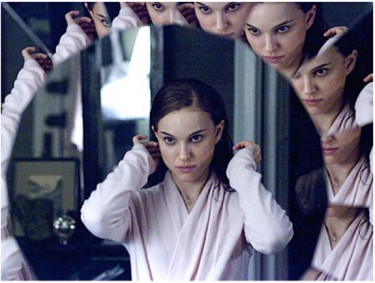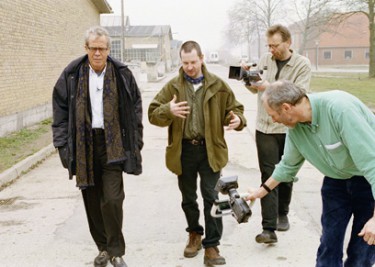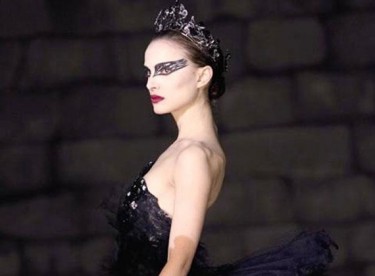 Back to selection
Back to selection
The Perfect Swan
(Editor’s Note: This essay contains spoilers.)
 In literature or in oratory, where rhetoric arose from, it’s somewhat difficult to separate the argument’s mode of persuasion from its substance. In order to make an entirely skilled rhetorical point, the writer or speaker will have to present a series of assumptions and assertions, facts and hypotheses, in such a way that makes the argument’s substance apparent. That’s why literature lends itself to the intellectual: it’s founded upon a progression of ideas.
In literature or in oratory, where rhetoric arose from, it’s somewhat difficult to separate the argument’s mode of persuasion from its substance. In order to make an entirely skilled rhetorical point, the writer or speaker will have to present a series of assumptions and assertions, facts and hypotheses, in such a way that makes the argument’s substance apparent. That’s why literature lends itself to the intellectual: it’s founded upon a progression of ideas.
Cinema is often referred to as a different kind of linguistic medium (the “language of film”), but a linguistic one nevertheless, and it’s true that cinema has its own rhetorical tools. A film’s style — the sum total of its formal decisions — becomes a mode of rhetoric, as the film tries to advance any number of points. The points being advanced aren’t necessarily didactic in nature — it’s not like every, or even most, movies are trying to “tell us” something directly – but as a movie progresses, it builds an argument, a case, whether it wants to or not. The problem is that, while text or speech is (to a certain extent) predicated upon an argument that follows a logical progression, cinema can make its arguments in a less logical fashion.
I found myself thinking about all this after I saw Black Swan last Friday. The film is utterly compelling, stylistically superb, but it advances a few ideas about art that I realized, after the haze of the film’s compelling rhetoric faded, I entirely disagreed with. Yet that didn’t diminish my enjoyment at all; the film’s rhetoric/style and its ideology were two separate things for me, even though the film uses the former to advance the latter. This separation is hardly an uncommon thing — for an extreme example, think of Triumph of the Will, which is a stylistically superb film that advances an appalling ideology; ditto Birth of a Nation.
Still, the more I thought about Black Swan, the more it began to bug me: the movie was so much fun to watch, yet it seemed to be saying things about the nature of art and artists that were entirely wrong. I found myself trying to grapple with the ideas the film advanced, separating them, post-facto, from how the film came to support them. When you strip away the persuasive tonal control exerted by Aronofsky, the thoroughly consistent camerawork, music and cutting, what is one left with? Black Swan advances two major points regarding art. The first is advanced by Vincent Cassel’s company director, Thomas; the second by how the film’s narrative plays out in the end.
1) The types of artists can be generally divided into a binary: the anal White Swans that exercise utter control over their formal prowess, and the debauched Black Swans that lose themselves in the madness of their art. The truly great artists must tap into both.
2) Utter perfection in art can only be achieved at the expense of the destruction of the artist.
The first assertion creates a very general binary, but there’s absolutely some truth to the contention that most artists can fall into the category of either White Swan or Black Swan. Cinema has had its fair share of both — White Swans like Kubrick, Antonioni, Haneke, who maintain an absolutely OCD formal precision, never allowing their work to stray far from the tone that has been struck — and Black Swans like Fellini, Herzog, or Derek Cianfrance, who thrive on chaos, who lose themselves in the madness of their work (Blue Valentine, the best film of 2010, is a Black Swan-film if ever there was one). Interestingly enough, Darren Aronofsky himself is one of the directors who immediately comes to mind as an artist who contains elements of both swans (alongside David Lynch and Gaspar Noe), which explains in part the project’s appeal to him — it allows him to continue having an acute atmospheric consistency, as he put forth in his first three films, alongside a visual and narrative delivery that embraces the wild, the mad, the excessive — like The Wrestler. However, Aronofsky’s ability to be both swans doesn’t mean he’s a greater filmmaker than anyone else mentioned above, let alone even as good — it’s just an observation. Great art comes from great execution — it’s not predicated on what the particular style or styles of the work is, but rather, on how well that style is articulated.
While Black Swan seems to advance praise for both methods of artistry — Natalie Portman’s Nina is commended early on for her ability to dance the White Swan — it is clearly advocating the merit of the Black Swan style, as the film focuses on Nina’s journey to be able to inhabit that mode. In effect, the point made is that to be the White Swan — an artist who is cool, in control of each facet of one’s work, a perfectionist — is to come up short as an artist, to be unable to tap into something ultimately human that is advanced by inhabiting the more carefree, reckless Black Swan artistry. Is that true, I wondered? Can great art only be made by allowing for a certain lack of formal control?
There is one very, very black Black Swan that I purposefully didn’t mention in the earlier list. That filmmaker, of course, is Lars Von Trier, the cinema’s uber-Black Swan and greatest advocate of what Thomas tells Nina to do — letting oneself go in one’s art. Jorgen Leth’s The Five Obstructions, in fact, fits perfectly as a companion piece to Black Swan. In that documentary, Von Trier is the Thomas to Leth’s Nina — only in this scenario, Thomas is picking on someone his own size. If Von Trier is the Black Swan incarnate, it’s difficult to imagine many films that are more cool, more controlled, deliberate and precise than the White Swan work of Leth’s The Perfect Human. Entirely shot against a white background in stark black & white, the film is an enigmatic, charming short that examines two people — a man and a woman, both formally dressed — as they eat, sleep, shave, and so on. Deceptively simple, the film’s detached surface affect belies a deeper, profound appreciation of the minutiae of existence. It is also perhaps the most formally consistent film I’ve ever seen.
 In the beginning of The Five Obstructions, Von Trier explains that he wants to do a kind of “artistic therapy” on Leth, by forcing him to remake the film five times with various limitations. Von Trier explains to Leth, cheerfully, that he wants Leth to “move from the perfect to the human” — in other words, he wants Leth’s remakes to suffer, to force Leth to make poor work, and hopefully, in the process, get Leth to see what it feels like to lose the total control over one’s work he so cherishes — so that he can become a better filmmaker. He wants to turn Leth into the Black Swan. At one point in the film, after Leth has slightly evaded one of Von Trier’s rules in order to do an incredible remake, Leth explains that “One always tries to make a better film.” Von Trier responds, “That’s what you mustn’t do. You always try to be too good. This isn’t filmmaking, this is therapy.”
In the beginning of The Five Obstructions, Von Trier explains that he wants to do a kind of “artistic therapy” on Leth, by forcing him to remake the film five times with various limitations. Von Trier explains to Leth, cheerfully, that he wants Leth to “move from the perfect to the human” — in other words, he wants Leth’s remakes to suffer, to force Leth to make poor work, and hopefully, in the process, get Leth to see what it feels like to lose the total control over one’s work he so cherishes — so that he can become a better filmmaker. He wants to turn Leth into the Black Swan. At one point in the film, after Leth has slightly evaded one of Von Trier’s rules in order to do an incredible remake, Leth explains that “One always tries to make a better film.” Von Trier responds, “That’s what you mustn’t do. You always try to be too good. This isn’t filmmaking, this is therapy.”
For the first remake, one of Von Trier’s rules is that no edit in the film can be longer than 12 frames. For good measure, he also decides to send Leth to Cuba, where he’s never been before (he gets the idea because Leth lights up a cigar as they talk), and, once Leth expresses his desire to shoot on a set, Von Trier explains that “in that case, you can’t do that.” And oh, Von Trier adds, “There are questions in the narration of the original short — I want you to answer them.”
The 12 frames alone would be enough to send most filmmakers off their perch of control, out of their typical style and tone. Not Leth. By ingeniously cutting just a few frames out of longer takes, he manages to string together a hypnotically beautiful film, much of which plays like bizarre (but beautiful) stop-motion animation. The arch coolness of Leth’s original remains absolutely intact. “The twelve frames were a gift,” he tells Von Trier later. The subsequent obstructions — make the film in the worst place on Earth, make it as an animated film, make it without any obstructions (a particularly devious one) — leave no more of a mark on Leth than the first. He emerges from the crucible as great a filmmaker as ever, having made films whose obstructions he has merely used to reinforce the strengths and tenets of his original work. Von Trier was convinced that Leth would not be able to improve as a filmmaker until he was destroyed as an artist, much as Nina’s greatest performance is enabled by her own self-destruction. In fact, it was Leth’s ability to resist these attempts at destruction that revealed the heights of his artistry, his incredible ability to enforce his artistic vision regardless of the circumstances. The specificity and persistence of his vision, the uniqueness of his style, is too powerful to be transformed under any circumstances — he simply is the White Swan, and that is why he can make great art.
The point I’m making is not that artists always have to be the White Swan, that surrendering to the Black Swan is problematic; it’s that White Swans don’t always have to incorporate Black Swan elements in order to achieve artistic greatness, as Nina has to. Additionally, it’s that striving for perfection in art does not necessarily lead to the destruction of the artist, although certainly it can. Black Swan is correct in arguing that artists who strive for self-perfection unyieldingly can bring about their own destruction, artistically or otherwise, but the unspoken correlative to that is that Nina’s drive for perfection is not dissimilar from the drive that led Stanley Kubrick to do 80, 100 takes of a scene. The difference between Stanley Kubrick and Nina — and the reason why Nina destroys herself, whereas Kubrick didn’t — is that Kubrick was making his art in the style he was built to make it in, whereas Nina is not a Black Swan. You cannot force artistry, you cannot force an artist with the drive for perfection to work in a method or realm that is foreign to where their strengths and natural tendencies lie, and the fact that Black Swan glosses over this point is what makes the film a lie. If Nina had remained in White Swan-type roles, she could have continued to strive for perfection with the same determination she exhibited for her roles in Swan Lake without destroying herself in the process. It is because she is wrong for the role that she ends up destroying herself trying to play it perfectly.
 Ultimately, that is the lasting message of Black Swan, whether Aronofsky realized it or not — you can’t turn a White Swan into a Black Swan, nor vice-versa, and especially not when a fierce determination to reach perfection is involved. What Thomas asks of Nina may be acceptable for the average ballerina, but for someone as driven as Nina it’s a toxic request. The real question, of course, is whether or not “the film” itself shares Thomas’s viewpoint: that art is not only about control, but losing control — that great artists must be both swans. I think that it does, and by sharing that viewpoint it unfairly condemns Nina to death. It shares this viewpoint because Aronofsky himself, as mentioned earlier, is such an artist — he is both swans. What Aronofsky fails to realize is that utterly, utterly committed artists tend to be quite singular in their styles and directions – they don’t go broad, they go deep. When you look over the oeuvre of the greatest names cinema has given us — Godard, Tarkovsky, Bresson, Hitchcock — you don’t see artists who are bending themselves to do one thing or another. You don’t see artists who have even the slightest room for variation. You see artists who pick one film and remake it over and over again for the rest of their career. I’d happily make that argument even for the shape-shifting Godard, who has gone through six periods in his career thus far, yet every film he makes is resoundingly his own. To make Nina play the Black Swan is to attempt to destroy her style as an auteur.
Ultimately, that is the lasting message of Black Swan, whether Aronofsky realized it or not — you can’t turn a White Swan into a Black Swan, nor vice-versa, and especially not when a fierce determination to reach perfection is involved. What Thomas asks of Nina may be acceptable for the average ballerina, but for someone as driven as Nina it’s a toxic request. The real question, of course, is whether or not “the film” itself shares Thomas’s viewpoint: that art is not only about control, but losing control — that great artists must be both swans. I think that it does, and by sharing that viewpoint it unfairly condemns Nina to death. It shares this viewpoint because Aronofsky himself, as mentioned earlier, is such an artist — he is both swans. What Aronofsky fails to realize is that utterly, utterly committed artists tend to be quite singular in their styles and directions – they don’t go broad, they go deep. When you look over the oeuvre of the greatest names cinema has given us — Godard, Tarkovsky, Bresson, Hitchcock — you don’t see artists who are bending themselves to do one thing or another. You don’t see artists who have even the slightest room for variation. You see artists who pick one film and remake it over and over again for the rest of their career. I’d happily make that argument even for the shape-shifting Godard, who has gone through six periods in his career thus far, yet every film he makes is resoundingly his own. To make Nina play the Black Swan is to attempt to destroy her style as an auteur.
Aronofsky doesn’t see this — if he did, the film would give Nina some recourse, there would be some moment where she argues or insinuates that to dance the Black Swan is not in keeping with her style of dance, her strengths as an artist; Nina is so committed that perhaps she herself wouldn’t mention that, but the film would find a way to express it. Instead, the film believes that Nina’s initial inability to “lose control” is indeed an artistic shortcoming, because for Aronofsky, playing both swans is how he has gotten by. Aronofsky is a talented filmmaker (Requiem For A Dream was one of those films that made me want to make movies, and it has an enormous sentimental value to me) but his career has been an unsteady one as he has bounced back and forth a bit, slowly trying to find his groove. He is a great filmmaker, but he is not a singularly driven artist in the manner of the gentlemen listed in the previous paragraph. Nor is he as talented as the protagonist he unfairly asks miracles of.

Zachary Wigon is a New York-based screenwriter and film critic. Since graduating from NYU’s film school in 2008, he has contributed writing on film to The L Magazine, The Onion A/V Club, NYLON magazine and The House Next Door, amongst other outlets. His first feature screenplay, For Your Entertainment, is currently in pre-production.
